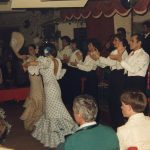The French have always been thought of as the most romantic people on the planet. And their wedding traditions reflect that sentiment. A French wedding brings a certain je ne sais quoi to the special day, especially if France is also the destination for the ceremony. The impeccable locations, the cuisine, the traditions and the venues all reflect the French spirit.
If you want to get married in France or just want a touch of the famous French elegance on your big day, here are a few things you need to know!
Background
The history of marriages in France is closely tied to the culture of the country. The French are also responsible for the widespread adoption of many of our iconic wedding symbols. The tradition of a bride wearing a white gown began in France. So did the legacy of the bridal hope chest, also known as the ‘trousseau’.
Once a wedding date is decided, the guests are sent a ‘un faire-part’, a wedding invitation that’s both formal and ornamental.
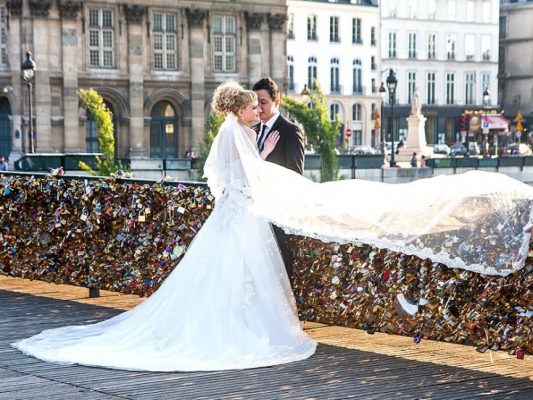
Even the process of responding to wedding invitations with RSVPs is a French custom. The word RSVP stands for ‘repondez s’il vous plait’. And this custom has now been adopted by most of the world.
Some close friends and guests will also be sent an additional card that is an invitation to the ‘repas de noce.’ This is basically the wedding banquet held after the wedding ceremony.
The Bride
There are no ‘star-brides’ at a French wedding. Or as the Americans like to call them, ‘Bridezillas’! The big day is seen as a celebration of the union of two families. There isn’t an entire team of people dedicated to keeping the bride’s every wish fulfilled.
In the same way, the groom is also expected to contribute equally to the wedding ceremony. For example, when the bride is given an engagement ring, she responds by offering the groom a watch in return.
This ceremony is a way to show that the couple are equal in their new union. And the families are meant to support the couple in the same way.
The Wedding Procession
The wedding procession in France is a unique experience on its own. The groom traditionally comes to pick up his bride on the morning of the wedding.
Then the procession begins from the bride’s house to the venue of the wedding ceremony. Musicians hired by the family are usually in the front of the line. They will be the ones leading the procession with songs and cheers for the married couple.
On the way to the church, the children from either families or their communities line up ahead of the procession. Their job is to block the path of the procession with white ribbons stretched across the road.
The bride carries a pair of scissors with her to cut through the ribbons and make way for the procession. It is considered a symbol of her strength to overcome any challenges that may arise in her marital life.
La Mairie
France has its own unique tradition of binding couples known as ‘La Mairie’.
It is more a legal procedure than a custom. The couple is supposed to be present at the town hall with the Mayor. The La Mairie is considered a ‘public event’ and the doors of the town hall are kept open throughout the process.

The open doors are there so that anybody who wishes to oppose the marriage can speak up. The La Mairie is the only legal way to get married in France.
Many French couples who have a religious background have the religious ceremony after the La Mairie. The spiritual and the physical are meant to be represented by the dual ceremonies.
Croquembouche
The French also don’t have a wedding cake. Well, they don’t have any cake we are used to seeing at weddings!
What you will see instead of a cake is called a ‘croquembouche’. It’s a pyramid made of dough balls filled with vanilla cream. This custom dates back to the middle ages where a wedding would be a grand communal affair. Each guest would bring a small cake with them and pile them all together on the banquet table.
The cake can also be made out of macrons or other French pastries. All piled high in a conical shape, of course. It is a very unique experience as the ‘croquembouche’ is often decorated to reflect the theme of the wedding.
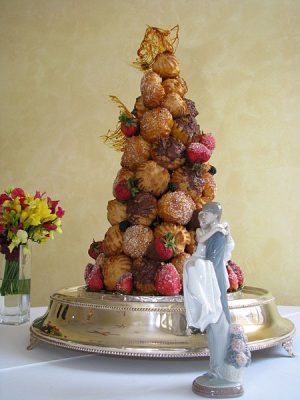
The Reception
Wedding receptions in France are typically an all-day/overnight affair. So if you’re down to get down till the break of dawn, you will love a French wedding!
Typically the La Mairie is the first event in the morning of the wedding day. Once the civil ceremony is over, it is followed by a religious ceremony. Depending upon the couple, the ceremony can be held at a Church or an equivalent for any other religion.
Once the matrimonial bond is finalised, the time for the cocktail reception begins. It is known as ‘vin d’hnonneur’. The cocktails are followed by a 4-5 course meal. This is also when the dancing begins and carries on till the next morning.
The Champagne
A tradition in France that has been kept alive since Napoleon’s days is called ‘Sabrage’. It basically involves using a sabre or a sword to open up a bottle of champagne. It sounds cool and looks even cooler!
Another custom that is adopted from the French by the rest of the world is the Champagne Pyramid.
You can see it being done by an expert bartender who stacks champagne glasses in the shape of a pyramid. Then he pours the liquor into the top glass and it flows like a waterfall filling up the rest of the glasses at the bottom.
A word of caution, be aware of flying corks in your direction when the champagne is being opened with a sabre!
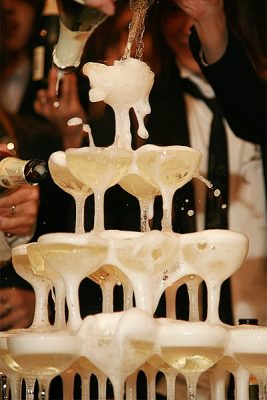
Dragee
If you’ve ever attended a wedding in the 90’s, you will be pretty familiar with what a dragee is. They are basically candies made from almonds coated in sugar and are brightly coloured.
In France, these almonds hold a lot of significance and are usually reserved to be given to guests on important days. The custom for weddings is that every guests receives 5 dragees each. Therefore, each individual dragee is meant to symbolise health, wealth, happiness, long life and fertility.
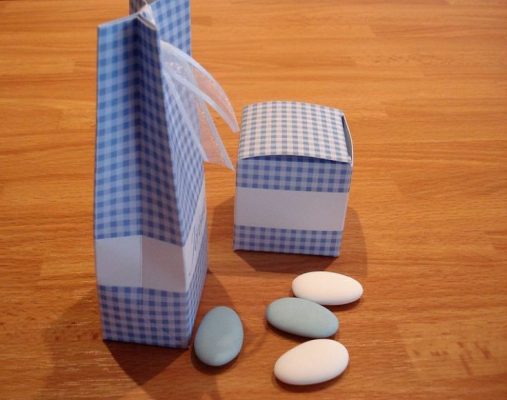
La Soupe a l’Oignon
Onion soup is at the centre of French cuisine and jokes made at the expense of French people. On a wedding day, or to be more specific, the wedding night, it holds a very special place.
It is served steaming hot in the early hours of the morning the day after the wedding. Most guests would have been drinking all night therefore the soup acts as a hangover cure and a nourishing meal.
The bowl of soup allows the guests to recover their strength to get home. And it also provides a way for the wedding party to end on a happy, warm and satisfied note.










